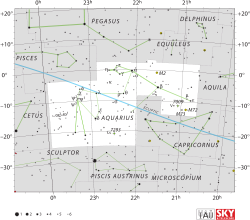25 Aquarii
| Observation data Epoch J2000 Equinox J2000 | |
|---|---|
| Constellation | Aquarius |
| Right ascension | 21h 39m 33.26758s[1] |
| Declination | +02° 14′ 36.8173″[1] |
| Apparent magnitude (V) | +5.09[2] |
| Characteristics | |
| Spectral type | K0 III[3] |
| U−B color index | +0.90[2] |
| B−V color index | +1.032[4] |
| Astrometry | |
| Radial velocity (Rv) | –34.63 ± 0.11[4] km/s |
| Proper motion (μ) | RA: –29.55[1] mas/yr Dec.: –83.22[1] mas/yr |
| Parallax (π) | 14.40 ± 0.30 mas[1] |
| Distance | 226 ± 5 ly (69 ± 1 pc) |
| Details | |
| Radius | 11[4] R☉ |
| Luminosity | 54[4] L☉ |
| Surface gravity (log g) | 2.5[4] cgs |
| Temperature | 4,721[4] K |
| Metallicity [Fe/H] | –0.17[4] dex |
| Rotational velocity (v sin i) | 2.5[4] km/s |
| Other designations | |
| Database references | |
| SIMBAD | data |
25 Aquarii (abbreviated 25 Aqr) is a single[3] star in the equatorial constellation of Aquarius. 25 Aquarii is the modern Flamsteed designation; in the past it held the designation 6 Pegasi.[6] It also bears the Bayer designation of d Aquarii. It is located near the border with the modern Pegasus constellation. Although faint at an apparent visual magnitude of +5.09,[2] it is bright enough to be viewed from suburban skies. Based upon an annual parallax shift of 0.01440 arcseconds,[1] it is located at a distance of around 226 light-years (69 parsecs) from Earth. The visual magnitude of the star is diminished by 0.09 from extinction caused by intervening gas and dust.[7]
The spectrum of this star matches a stellar classification of K0 III,[3] with the luminosity class of III indicating that this is a giant star that has evolved away from the main sequence after exhausting the supply of hydrogen at its core. It belongs to a population known as clump giants and hence is generating energy through the nuclear fusion of helium at the core.[8] The outer envelope has expanded to 11 times the radius of the Sun and it is radiating 54 times the Sun's luminosity.[4] This energy is being emitted from the stellar atmosphere at an effective temperature of 4,721 K,[4] causing it to glow with the orange hue of a K-type star.[9]
References
- ^ a b c d e f van Leeuwen, F. (November 2007), "Validation of the new Hipparcos reduction", Astronomy and Astrophysics, 474 (2): 653–664, arXiv:0708.1752, Bibcode:2007A&A...474..653V, doi:10.1051/0004-6361:20078357.
- ^ a b c Argue, A. N. (1966), "UBV photometry of 550 F, G and K type stars", Monthly Notices of the Royal Astronomical Society, 133: 475–493, Bibcode:1966MNRAS.133..475A, doi:10.1093/mnras/133.4.475.
- ^ a b c Eggleton, P. P.; Tokovinin, A. A. (September 2008). "A catalogue of multiplicity among bright stellar systems". Monthly Notices of the Royal Astronomical Society. 389 (2): 869–879. arXiv:0806.2878. Bibcode:2008MNRAS.389..869E. doi:10.1111/j.1365-2966.2008.13596.x.
{{cite journal}}: CS1 maint: postscript (link) CS1 maint: unflagged free DOI (link) - ^ a b c d e f g h i j Massarotti, Alessandro; et al. (January 2008), "Rotational and Radial Velocities for a Sample of 761 HIPPARCOS Giants and the Role of Binarity", The Astronomical Journal, 135 (1): 209–231, Bibcode:2008AJ....135..209M, doi:10.1088/0004-6256/135/1/209.
- ^ "* d Aqr". SIMBAD. Centre de données astronomiques de Strasbourg. Retrieved 2012-07-13.
{{cite web}}: CS1 maint: postscript (link) - ^ Wagman, M. (August 1987), "Flamsteed's Missing Stars", Journal for the History of Astronomy, 18 (3): 220, Bibcode:1987JHA....18..209W, doi:10.1177/002182868701800305.
- ^ Famaey, B.; et al. (January 2005), "Local kinematics of K and M giants from CORAVEL/Hipparcos/Tycho-2 data. Revisiting the concept of superclusters", Astronomy and Astrophysics, 430: 165–186, arXiv:astro-ph/0409579, Bibcode:2005A&A...430..165F, doi:10.1051/0004-6361:20041272.
- ^ Alves, David R. (August 2000), "K-Band Calibration of the Red Clump Luminosity", The Astrophysical Journal, 539 (2): 732–741, arXiv:astro-ph/0003329, Bibcode:2000ApJ...539..732A, doi:10.1086/309278.
- ^ "The Colour of Stars", Australia Telescope, Outreach and Education, Commonwealth Scientific and Industrial Research Organisation, December 21, 2004, archived from the original on February 22, 2012, retrieved 2012-01-16.

